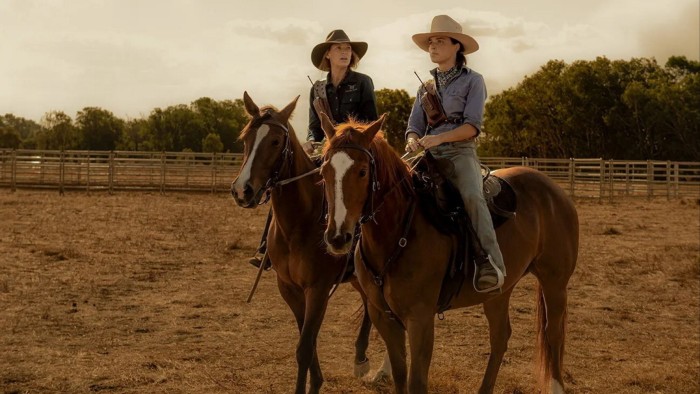Unlock the Editor’s Digest for free
Roula Khalaf, Editor of the FT, selects her favourite stories in this weekly newsletter.
Australian producers are often asked for “red dirt or white sand stories” when pitching TV shows to an international audience. The desolation and threatening aura of the outback, or the sprawling beaches festooned with surfies in bikinis and budgie smugglers — these backdrops seem to dominate the imaginations of overseas commissioners.
Territory, a blood and guts Australian saga set on a cattle station in the remote Northern Territory, opens with a main character being eaten alive by wild dogs. Globally, it was one of Netflix’s best watched programmes last year.
On worldwide streaming platforms, Australian stories have carved out a niche as idiosyncratic as Scandi noir. The country’s TV industry, historically a curio best known for cheap soap operas and Skippy the Bush Kangaroo, has grown in stature. Successes such as Bluey, about a cartoon cattle dog and the most streamed programme in the world in 2024, offbeat comedies like Colin From Accounts and fraudulent wellness docudrama Apple Cider Vinegar, have given local producers a huge reach.
But the vast audiences provided by US tech giants come at the price of control. In 2022, Amazon MGM Studios revived Neighbours, the star-making but relentlessly dull soap opera set in the Melbourne suburbs that captivated British viewers for four decades. It then decided to cancel it. Netflix’s decision not to renew Territory for a second season shocked the entire industry, underscoring its vulnerability to decisions made in another country. “You’re at the end of a long limb,” said Rob Gibson, chief executive of Easy Tiger Productions which made the show.
The resulting feeling of existential risk has reignited a push to legislate a long-held plan to impose local content quotas on streamers, forcing companies like Netflix, Disney and Amazon to reinvest up to a fifth of their locally-derived revenue back into local productions.
Local content laws were first introduced in Australia in the early 1960s, when the dominance of British and US TV shows gave rise to concerns about what was deemed cultural imperialism and the loss of the Australian voice. “Australianess” — whatever that means in a multicultural society — then became the focus as local content quotas were updated in following decades.
In the broadcast era, these laws helped Australia to produce a steady stream of shows, including Neighbours and Home & Away. Both soaps were launching grounds for well-known actors including Margot Robbie and Russell Crowe. But streaming platforms do not need to adhere to the rules, meaning they buy content when and if they feel like it.
On the face of it, Australian TV production has thrived. Amazon Prime, which released an Aussified-version of The Office last year, said it has commissioned 30 original shows since 2019. Netflix spent A$1bn ($629mn) on Australian content between 2019 and 2023 and more since.
But the surge may be shortlived. After a record three-year period, the latest Screen Australia Drama report showed investment in local shows and movies fell nearly a fifth in the last fiscal year.
If streaming companies are losing interest in Australian content, local broadcasters who have lost audience share are unlikely to fill the gap. Hence the argument that local content rules be extended. Similar arguments have started to emerge elsewhere. Peter Kosminsky, the director of Wolf Hall, has called for a UK content levy for streaming companies.
Australia’s Labor government said it would introduce a local content quota by mid-2024. But the plan remains in development (or consultation as politicians would put it) with no firm timeline for implementation. The government appears more focused on convincing President Donald Trump to maintain a “friendly” stance on trade than picking a fight with US streamers.
Nonetheless, content laws may be worth the fight. France, always protective over its culture, has already implemented its own quota on US streamers. A “Neighbours Tax” for the digital content age would help Australia keep turning its red dirt and white sand stories into TV gold.
Read the full article here

